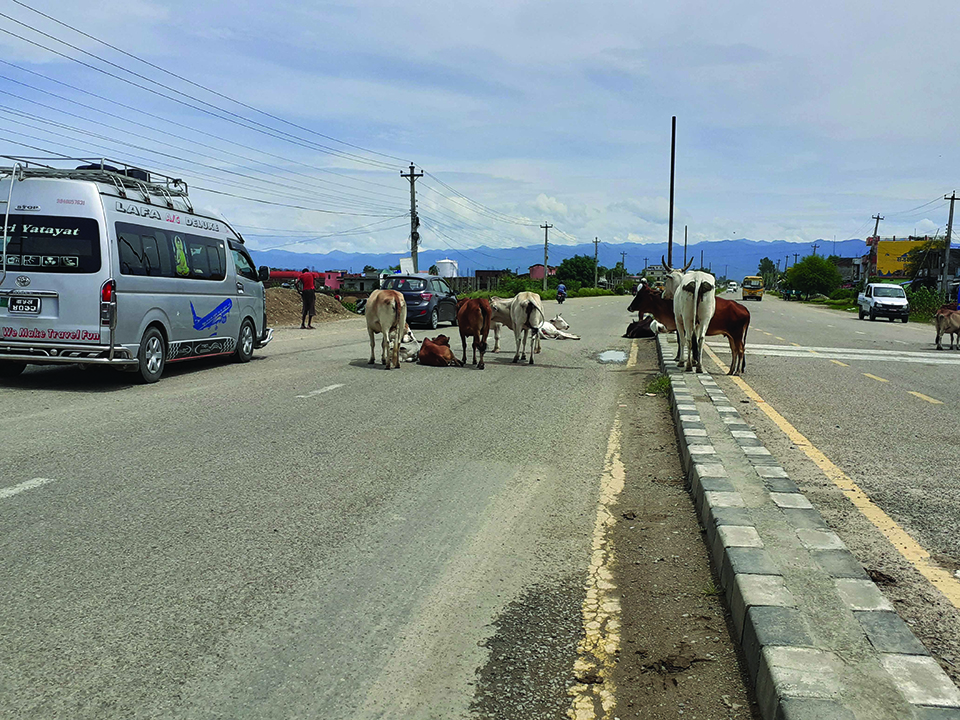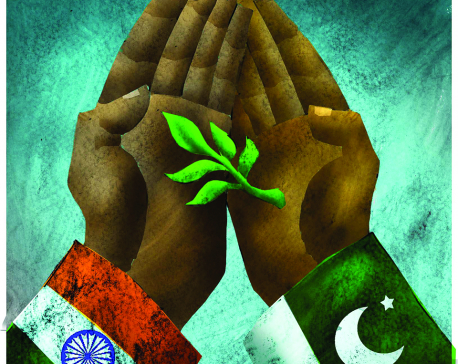
OR
'India's stray cattle causing nuisance in Nepalgunj'
Published On: August 15, 2019 03:30 AM NPT By: Arjun Oli

NEPALGUNJ, Aug 15: Stray cattle have become a significant source of worry for the locals of Nepalgunj these days. Be it roads or marketplace, cows and oxen block ways causing accidents. According to the local authorities, 80 percent of these stray cattle have come from India. And more such cattle are making their way to Nepal through the border every day.
Though the sub-metropolis has increased the number of sheds for stray cattle this year, it is still struggling to cope with the ever-increasing number of cattle, the majority of which it claims to be coming from India.
"80 percent of the stray cattle have come from India, they continue to come," claimed Dr Dhawaleshor Rana, mayor of the sub-metropolis. "When they have to abandon their cows and oxen, they chase it towards the Nepal border and do not leave until the cattle cross the border. People of several districts of Uttar Pradesh are doing so."
Locals in Nepalgunj report that they have seen a constant rise in the number of cattle in Nepalgunj in the last two years. And assert that they arrive from across the border. But things have gone crazy, and beyond tolerance, they say. Local have connected the growing number of stray cattle with the rise of BJP government in the southern neighbor citing its policy that discourages slaughter of the cow family.
Nepalgunj Sub-metropolis does have well-managed sheds for stray cattle, which was even expanded last year. However, considering the ever-growing number of abandoned cattle, it is becoming smaller.
"There were around 1000 stray cattle last year, this time it's over 2000 and the number is just shooting up," lamented Rana.
While there were two small sheds earlier at ward number three of the sub-metropolis, the authority last year added more sheds in additional three bighas of land. But the municipality is short of space and resources to increase the shed.
Indo-Nepal border side covers around 65 kilometers in Banke. And once their cattle cross into Nepal, the owners leave.
"Humans go through the security check at the border, but what to do with cattle! They cross the border easily from anywhere" said Rana.
Rana further stated that it is not practical or possible to have guard the borders to stop Indian cattle from entering into Nepal.
Last year, the local body had cornered many stray cattle, load them into trucks and left them around the highway. But that helped little in limiting the numbers as some of them returned after some days. Present the sub-metropolis is taking care of around 500 stray cattle in its sheds.
"We are finding it very hard to manage resources for the growing number of cattle. We don't have the capacity to manage so many cattle. It is getting very costly," Rana stated.
Despite its claim, the sub-metropolis is being criticized for failing to manage stray animals and protect animal rights. Social media users have vented ire at it. The issue is slowly drawing the interest of politicians.
Minister for Urban Development, Mohammad Istiyak Rai, recently announced to provide Rs 10 million to the sub-metropolis for the managing stray cattle. He has already handed over Rs 50,000 to a local animal right activist group.
Deputy Mayor of the sub-metropolis, Uma Thapa Magar, agreed that there has been chaos in Nepalgunj due to the animals and stressed on the need to fix the issue without delay.
"It has already become late to address the issue. This might go beyond control if action is not taken right away," she said.
Thapa suggested that the cattle's arrival should be stopped right at the border at any cost.
Police Chief in Banke, SP Bir Bahadur Oli thinks that is easier said than done. Echoing the Mayor, Oli said that the borderline is too long and it is very challenging to control cattle by posting security personals along the border.
"We could do something if they came loaded in vehicles. But they don't come that way. The border is open, they come from anywhere from the 65 kilometers of the border," Oli stated.
Moreover, he stressed that it is not possible to identify cattle's nationality. "You cannot identify the nationality of cattle by looking at it," he noted.
====
===
You May Like This

Bringing peace in Kashmir
India and Pakistan should engage in dialogue with or without external mediation to find lasting solution of Kashmir problem ... Read More...

Aug 10: 6 things to know by 6 PM today
Your daily dose of missed important news of the day. ... Read More...

India expresses sorrow over loss by devastating thunderstorm
KATHMANDU, April 2: India has expressed sorrow over the loss of life and damage to property in the devastating thunderstorm... Read More...




Just In
- Nepal-Qatar Relations: Prioritize promoting interests of Nepali migrant workers
- Health ministry to conduct ‘search and vaccinate’ campaign on May 13
- Indian customs releases trucks carrying Nepali tea, halted across Kakarbhitta
- Silent period for by-election to begin from midnight
- SC issues short-term interim order to govt and TU not to take immediate action against TU legal advisor Khanal
- National consultation workshop advocates to scale up nutrition smart community in Nepal
- Patan High Court issues short-term interim order to halt selection process of NTB’s CEO
- NEPSE inches up 0.15 points; daily turnover increases to Rs 2.53 billion













Leave A Comment